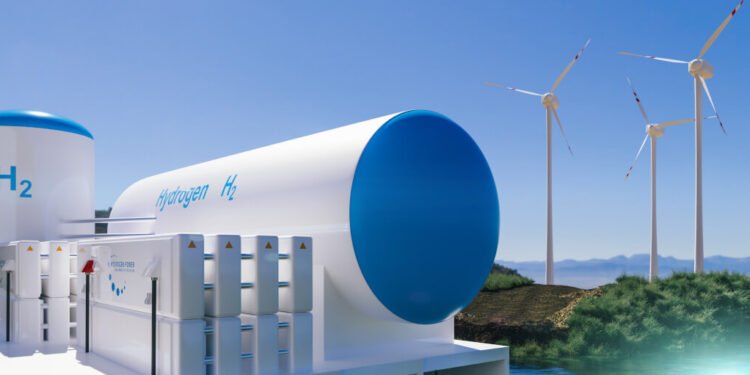For a vessel to be set into motion, a great deal of energy is needed based on an efficient fuel and the shipping industry is seeing hydrogen as a promising solution to fill in this role. Despite being the lightest gaseous element in the world, hydrogen can provide a high energy density, almost three times as much as the one of natural gas, which is expected to accelerate hydrogen technology towards 2030.
Accounting for around 3% of the world’s GHG emissions and emitting nearly one billion tons of CO2 annually, shipping has been facing a growing pressure to shift to decarbonization solutions. A landmark point was the IMO’s 2018 strategy calling for a 50% reduction in GHG emissions by 2050, compared to 2008 levels, in order to align the industry with the Paris Agreement, at a time when reducing emissions is a hot debate worldwide. This landscape has made shipping exploring decarbonization projects and fuel alternatives to lay the ground for a more sustainable future.
The key argument for the ‘hydrogen in shipping’ case compared to other fuel alternatives is the relative ease of retrofitting existing ships with hydrogen fuel cells. A Global Maritime Forum study in early 2021 examined 106 projects focused on zero emissions in shipping globally and found that almost half of these focused on hydrogen as a low-carbon solution. Notable is that oil major Shell is seeing hydrogen as the most beneficial over other potential zero-emissions fuels for shipping, which is why it has invested in several hydrogen production projects in Europe and China. Having shown a great interest in hydrogen over the last years, the Port of Rotterdam initiated a hydrogen shore power pilot project last month, to begin in late 2022.
Currently, most hydrogen is produced from fossil fuels, specifically natural gas. However, a growing pressure to achieve climate goals internationally has made green hydrogen an attractive solution for the shift to low carbon economy, at a time when studies show that “blue” hydrogen may harm the climate more than burning fossil fuel. And while the world is striving to transit from fossil-based hydrogen, it is expected that grey hydrogen will play the leading role in the near future until the green hydrogen value chain matures to commercialization.
But what do ‘blue’, ‘green’, and ‘gray’ hydrogen stand for?
‘Grey’ hydrogen production takes place through a practice called Steam Methane Reforming (SMR). Under SMR, high pressure steam (H2O) reacts with natural gas (CH4) which results in hydrogen and CO2. At the moment, ‘grey’ hydrogen is the most common form of hydrogen produced worldwide.
‘Blue’ hydrogen (also seen as ‘low carbon hydrogen’) involves the carbon capture and storage (CCS) of the CO2 released during the production of grey hydrogen. Currently, blue hydrogen is produces on large-scale only in the North Sea. Blue hydrogen is seen as a decarbonization solution as it helps reduce CO2 at relatively low cost. A Rystad Energy analysis released in early 2021 showed that CCS solutions could address about 42% of the world’s total dirty footprint.
‘Green’ hydrogen (also seen as ‘renewable hydrogen’) is produced with sustainable energy, mostly electrolysis, in which water (H2O) is split into hydrogen (H2) and oxygen (O2) via green electricity. Electrolysis is the only method that can convert electricity to hydrogen flexibly and then store it. What makes H2 attractive is that it is free of carbon emissions, which is why it is currently being examined as a decarbonization solution for shipping.
It becomes evident that the main difference of gray and blue from green hydrogen is that the first two are produced from fossil sources, while the latter is made from non-fossil sources and is currently seen as a more attractive option by policymakers who are wary of keeping the fossil economy going, even with CCS.
What are the current methods of hydrogen production?
Steam Methane Reforming and Coal Gasification are currently the two most common methods of hydrogen production globally:
-Steam methane reforming is the most widely used process for the generation of hydrogen, accounting for 48% of overall production globally. Under SMR, high-temperature steam (700°C–1,000°C) is used to produce hydrogen from a methane source, such as natural gas. Methane reacts with steam under 3–25 bar pressure in the presence of a catalyst to produce hydrogen, carbon monoxide, and a relatively small amount of CO2. Subsequently, under the “water-gas shift reaction,” the carbon monoxide and steam are reacted using a catalyst to produce CO2 and more hydrogen. In a final process step called “pressure-swing adsorption,” CO2 and other impurities are removed from the gas stream, leaving pure hydrogen. Steam reforming can also be used to produce hydrogen from other fuels, such as ethanol, propane, or even gasoline.
-Coal gasification accounts for 18% of the global hydrogen production. In this process, coal is converted into syngas — a mixture of CO, hydrogen, CO2, steam, and oxygen. To produce hydrogen, syngas is moved to a water-gas shift reactor, where CO in the gas is reacted with water to produce additional hydrogen and CO2. These are then separated, producing two hydrogen molecules and three molecules of carbon.
Although blue hydrogen is currently cheaper than ‘green’ hydrogen, a Bloomberg NEF analysis last year showed that the situation could reverse by 2030, while even gray hydrogen could cost more than green hydrogen by 2030. However, it is more likely that hydrogen production using fossil fuels will continue to occupy a significant share in the near future due to the process readiness and efficiencies, while low-carbon production alternatives may be complementary, according to Krishnaveni Malladi, Consultant at WRI India.





























































